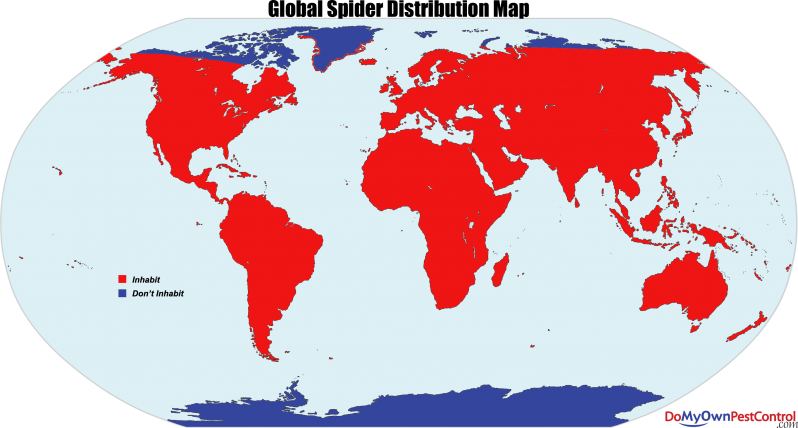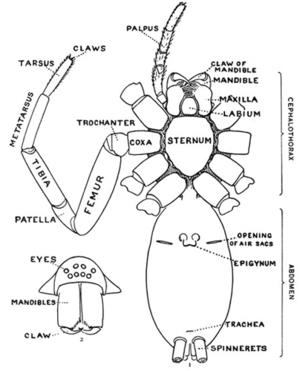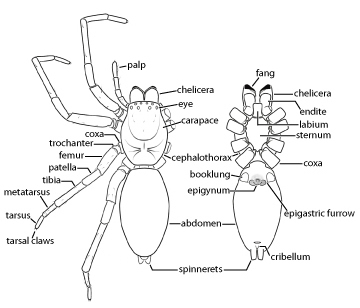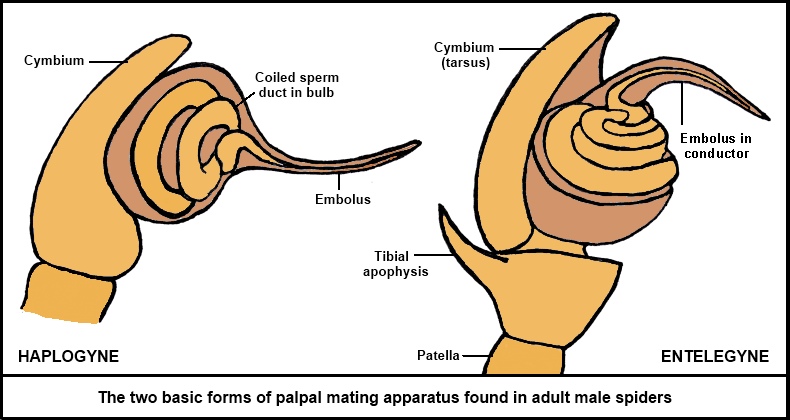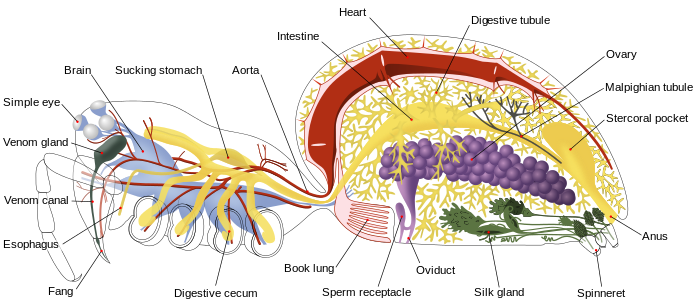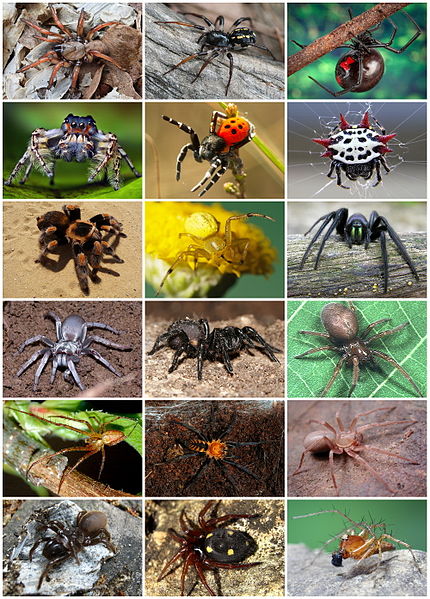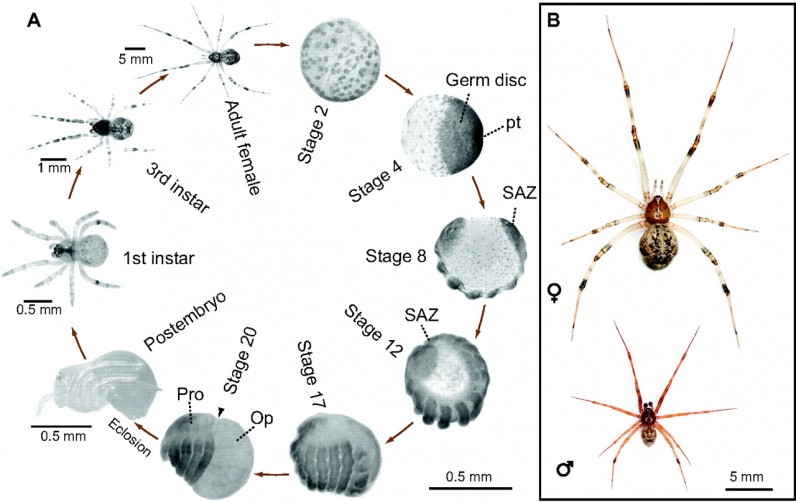All about the Different Types of Spiders, Spider Facts & More
See also:
What are Spiders?
Spiders are the invertebrate predator specialist of the animal kingdom. In comparison to their cousins the insects who make up over 89% if the arthropods, spiders rank second coming, in at around 6.6%. The lack of speciation in the Araneae order does not hinder these predators from inhabiting every known ecosystem inhabited by other arthropods. Spiders are masters of the hunt, camouflage, tricksters, and trappers. Hunting any invertebrate or small vertebrate prey they encounter, even other spiders.
The arachnids encompass respectively over 40,000 identified species worldwide, in which 3,400 species call North America their home. Spiders have eight legs, two body regions, and anywhere from two to as many as eight eyes. Sizes vary from family to family, as small as 1mm to 70mm or larger.
Spider Taxonomy
- Kingdom: Animalia
- This is kingdom of all animals on the planet or the multicellular complex organism group
- Phylum: Arthropoda
- This is the phylum of the invertebrates, or no bones
- They have exoskeletons, segments, and joints
- Order: Araneae (Spiders)
- In the order there are over 40,000 species of spider worldwide
- 3,400 of them are found in North America
- Order: Opiliones
- The order of the Harvestmen, and also known as the daddy long legs
- These are not spiders but close relatives
- There are 5,000 worldwide and 235 are native to North America
- Suborder Mygalomorphae
- Tarantula, trapdoor, purseweb, and funnelweb spiders
- Suborder Araneomorphae
- Known as the true spider order
- Class: Chelicerata
- Known as the Arachnids
Spider History
Where Do Spiders Come From?
The spider has a worldwide reputation. Spiders are perceived with mixed emotions, from being unwelcome, feared, loved, or respected throughout many cultures. The first spider to walk the earth was believed to be in the Triassic period. The period dates back to over 200 million years ago. Spider mythology tales have been told in cultures throughout history on the arachnid class. The Greeks told a story of a young foolish girl who challenged the great goddess Athena to a weaving contest. The girls name was Arachne. Athena made a marvelous spun master piece but it still fell short in comparison to the sheer perfection and detail of the young Arachne’s creation. In anger, the goddess punished the girl, turning her into a spider to live the remaining years of her life spinning.
The Native Americans also told stories involving the spider. The Navajo Indians spoke of a spider woman that taught the women of the tribe to weave. As for the Pueblo tribe, they spoke of a spider woman at creation. The Cherokee believed that the spider brought fire to their people. Spiders are also believed to have weaved dream catchers. The catcher caught the good dreams of life based on Sioux Indian tales.
Tales stretch the African cultures as well, speaking of the spider as the “Anansi,” meaning trickster. The spider was also seen as a source of inspirations by some cultures. The spider was a well-known and respected creature over the years.
Spiders are far less diverse in habits and morphology in comparison to the insects. Those facts aside, the order of spiders still inhabit all of the same terrestrial environments. Where there are other arthropods, spiders with be there to prey on them. The diversity of spiders can be noticed in the unique behaviors, mimicry, intricate webs, dwellings, and toxic venoms. Spiders’ body shape and design have changed very little over the millions of years they have been present on the earth.
Spider Map (Spider Locations)
The best way to know a spiders habitat is to know what they eat. They are found on every landmass where arthropods are found and thrive such as flies, ladybugs, aphids, ants, roaches, leaf bugs, grasshoppers, crickets, beetles, other insects, spiders as well, even small vertebrates like fish, and mice. Spiders can be hunters of any climate, from mountains, deserts, rivers, lakes, swamps, forest, rain forests, grasslands, cities, farms, and even your own home. The spider’s distribution spans every continent with the exception of Antarctica.
Spider Identification and Spider Morphology
See our spider identification guide for more information.
Spiders have two distinct body regions. The regions are called the cephalothorax and the abdomen. The cephalothorax region is hardened at the top acting as a shield called the carapace. The carapace holds the eyes, mouth, and eight legs. The abdomen region of the spider contains the silk glands and spinnerets.
The number of eyes varies between species. There can be two eyes or as many as eight eyes on the carapace. The orientation of the eyes also varies from family to family. The number and position of the eyes is a key to identifying the spider. The mouthparts on a spider are chelicerae, and they are tipped with fangs. Spider chelicerae for all but the families of the Mygaolomorphae suborder move side to side. The mygalomorph’s chelicerae move up and down. Fangs in spiders are hollow and deliver the venom that paralyzes and liquefies the prey’s insides.
The silk glands produce a liquid protein that dries on the exterior of the body into a useable silk. Spiders use three pairs of spinnerets to form and purpose the desired silk product. The spinneret acts as a valve that the spider uses to determine the thickness, strength, and stretchiness of the silk, and allows the spider to create up to seven different types of web. The dry silk forms strong fibers that allow spiders to repel from high surfaces, encase eggs, trap prey, wrap prey, and construct webs. The webs generated are also unique to each species for identification, and are sometimes used in courtship behaviors.
Male & Female Differences
The male and female spiders vary morphologically. The males are typically smaller, vary in color, and have pedipalps. The pedipalps are located on the carapace alongside the chelicera. They resemble a fifth set of legs, but this is actually where the male spider stores the sperm for reproduction. The sperm-storing organs are located at the end of each pedipalp resembling miniature boxing glove. The males have longer legs than the females. Male spiders are typically brighter colored and have more design features than females. The males typically have small poison sacs or venom sacs, or lack them completely.
The female spider is usually the larger, often doubling the size of the male. They have large poison sacs or venom sacs for the primary reason of protection. Spider females typically prefer to remain camouflaged with colors that are darker and match the surrounding habitat. This is so she can remain hidden and protect the eggs. Female spiders have external reproductive parts at the front and center of the abdomen called epigynum.
Female Spider
Image source: en.wikipedia.org
Female Reproductive Organs or Parts
Image source: findaspider.org.au
Male vs. Female Spider
Image source: mhi.si.edu
Male Spider Reproductive Organs or Parts
Image source: findaspider.org.au
Spider Anatomy
Spider Anatomy Diagram
Image source: en.wikipedia.org
See our spider identification guide for more information.
The carapace, along with holding the legs, also holds vital organs of the spider such as the stomach, aorta, brain, eyes, venom gland, venom canal, esophagus, fangs, pedipalps (only in males hold sperm), and digestive cecum. The abdomen of the spider however holds the heart, intestines, digestive tubules, ovaries, oviduct, sperm receptacle (only female), Malpighian tubule, silk glands, spinnerets, book lungs, stercoral pocket, and anus.
What is a spider?
All Spiders have:
- Two body regions:
- Carapace, and Abdomen
- Eight legs
- Multiple eyes
- Chelicerae & fangs
- Silk glands
- Venom sacs
- Spinnerets
Types of Spiders:
Image source: enwikipedia.org
There are many different kinds of spiders all over the world. The following is a list of the major types of spiders found in North America.
Desert Blonde Tarantula (Aphonopelma chalcodes)
- The Theraphosidae family which are the Tarantulas
- This species has a light brown color with a light carapace in females, and black brownish gray in males.
- The largest spiders in the world
- 50-70mm in size
- There are over 80 different kinds of these giant spiders in North America
- The North American distribution of this species is from Arizona, New Mexico, and Mexico
California Trapdoor Spider (Bothriocyrtum californicum)
- Ctenizidae Family
- 20-32mm or 3/4 – 1 ½ inches in size
- The spiders cap their ground level burrows with a snug fitting silk lid.
- They use the lid to spring out and surprise unsuspecting prey.
- California trapdoors typically make the burrows on warm and well vegetated areas
- Range of distribution: Southern California
Trapdoor Spider (Ummidia audouini)
- Ctenizidae Family
- 15-28mm or 5/8–1 1/8 inches in size
- The spiders cap their ground level burrows with a snug fitting silk lid.
- They use the lid to spring out and surprise unsuspecting prey.
- Burrows are typically found on steep river banks in riparian woodlands. The term riparian means woodlands that are on the banks of a river.
- Range is Illinois, Oklahoma, the Gulf states, to Virginia, and Florida.
Brown Recluse Spider (Loxosceles reclusa)
- AKA: Fiddle Spider or Violin Spider
- This is a six eyed spider, in the family Sicariidae
- ¼-3/8 inches or 7-10mm
- Yellow to brown mixed color
- The spider’s trade mark is an upside down fiddle design on the top of the carapace or violin shaped mark.
- The last recorded range of this spider was from South Texas to as far as East Ohio and Georgia, but the range is spreading.
Spitting Spider (Scytodes thoracica)
- Males are 1/8 inch or 3-4mm in size
- Females are 1/8-1/4 inch or 4-6mm
- Spiders are from the family Scytodidae
- They are called spitting spiders because they spit a gluey secretion on their prey. The glue subdues the victim and allows the spider to bite and inject its venom.
- The species distribution ranges from Southeast Canada to all of the United States east of Indiana
- Light to darker yellow with black mottling overall. Mottling is uneven patterns of spots.
Long bodied Cellar Spider (Pholcus phalangiodes)
- Spiders range in sizes from ¼-3/8 inches or 6-9mm
- These spiders are located in the family Pholcidae, known only as the cellar spiders.
- Species is found in south Canada and throughout United States
- Cellar spiders are characterized and named from the liking of hanging upside down on the celling in their webs in dark locations like garages, cellars, and attics
Globose Cellar Spiders (Psilochorus spp).
- Spiders vary in sizes from 1/8 of an inch or 3-5mm.
- These spiders are located in the family Pholcidae, known only as the cellar spiders.
- Globose Cellar spiders are found predominately in the Western United States to Oklahoma and Texas.
Sowbug Killer Spider (Dysdera crocata)
- Males are 3/8 of an inch or 9-10mm, and the females are 3/8-5/8 of an inch or 11-15mm.
- Spider is found in the family Dysderidae or the Dysderid spiders.
- Spiders are found all over North America.
- Shinny spider with a reddish orange carapace or darker. The abdomen is oval and tan to a purplish cream color.
Mexican Two-tailed Spider (Neotama Mexicana)
- This spider is characterized by “two tails” which are abnormally long spinnerets.
- In the Hersiliidae family, which are the two-tailed spiders
- Average size of this species is half an inch or 12mm
- The spider is found predominately in the southern tip of Texas.
Common House Spider (Achaearnea tepidariorum)
- AKA: American House Spider and Domestic Spider
- In the Theridiidae, which are the comb-clawed spiders
- Most common spider species in North America
- Males range from 3-5mm in size
- Females range from 5-6mm in size
- Found often in houses, barns, sheds, fences, bridges, and other structures
- Web designs are irregular:
- Typically found in corners or window angles
Brown Widow Spider (Latrodectus geometricus)
- Marked with a red or orange hour glass on the underside of the abdomen
- Usually a pale to light brown color
- In the Theridiidae, which are the comb-clawed spiders
- Common to Southern California, Southern Arizona ,to East Texas, to Georgia and Florida
- Active year-round
- Hunt from their cobwebs that are found near houses, sheds, barns, and other buildings.
- Males range from 3-8mm in size
- Females range from 7-17mm in size
Southern Black Widow Spider (Latrodectus matcans)
- AKA: Black widow
- This spider is common throughout North America
- In the Theridiidae, which are the comb-clawed spiders
- Shiny black color with a bright red hour glass on the underside of the abdomen
- Occasionally a row of tiny red dots are visible
- Male is about 3-6mm in size with white lines on the side of the abdomen
- Male also has a mixed brown a black color
- Female is about 8-10mm in size
- This spider is commonly known for its extremely toxic venom
- Webs are usually an irregular mesh of silk
- Found often in dark places, rodent burrows, cellars, crawl spaces, and under stones
False Black Widow Spider (Steatoda grossa)
- Found commonly in the coastal United States
- In the Theridiidae, which are the comb-clawed spiders
- Black glossy color, with pale or white spots on the abdomen
- This look alike to the Black Widow, but lacks the red hour glass mark,
- Also lacks the rounded abdomen shape of the True Black Widow
- Males are anywhere from 4-7mm in size
- Females are usually 6-11mm in size
Bowl and Doily Weaver Spider (Frontinella communis)
- Found throughout North America
- Sizes range from 3-4mm
- Brown to black in color, with two pale yellow racing stripes on the underside of the abdomen
- Webs are shallow bowl shaped
- Webs are usually made in tall grasses and bushes
- In the family Linyphiidae, which are the sheetweb spiders
Hammock Spider (Pityohyhantes costatus)
- Distribution ranges from southern Canada to the northern United States
- In the family Linyphiidae, which are the sheetweb spiders
- Sizes range from 4-7mm
- This species is known for weaving hammock-like webs, which they hide in awaiting potential prey
- Usually a white or pale yellow carapace with a forking line down the center
- On the middle of the abdomen there is a dark brown herringbone pattern
Golden Silk Orbweaver Spider (Nephila clavipes)
- AKA: Calico Spider or the Banana Spider
- In the family Tetragnathathidae, known as the long-jawed orb weavers
- Males range in sizes from 4-8mm
- Known for having a banana like color an shaped abdomen
- Females are moderately larger ranging from 22-25m
- Found commonly throughout the southern United States
- Females are characterized by a white, silvery carapace, with a mixed green, yellow, gold, orange-brown abdomen with white spots
- Males have a white, silvery carapace with a red orange abdomen
- Both males and females have yellow legs with black patches or bangs with hair/tuffs (typically two on each leg)
Long-jawed Orbweaver Spider (Tetragnatha spp.)
- Common design is slender longer abdomen region with an overall brown color, with silver to white spots on the abdomen
- Sometimes bear a dark band
- In the family Tetragnathathidae, known as the long-jawed orb weavers
- Found all over Canada and the United States
- Known for making nests on vegetation hanging over or near (moved in front of water)water , but the species is predominately a terrestrial dwelling spider
- Sizes ranging from 4-12mm
- Eggs are laced with a unique tented silk
Orchard Orbweaver Spider (Leucauge venusta)
- Brown with black and silvery striped carapace, with black and yellow tipped leaf vein lines.
- In the family Tetragnathathidae, known as the long-jawed orb weavers
- Males are about 4mm in size
- Females are anywhere from 5-7mm in size
- Found as far north as New England to as far south as Florida, and also in the southwestern part of California
Jeweled Orbweaver Spider (Araneus marmoreus)
- Gray, brown, purple color, with distinct spikey hairs
- The species is characterized with a uneven and humped abdomen
- One of the largest species in North America
- In the family Araneidae, known as the Orb weavers
- Males range from 6-9mm
- Females range from 9-25mm
- Reported to be found in south Alaska to California, Montana and Idaho.
Marbled Orbweaver Spider (Araneus marmoreus)
- Legs are white with black bands
- With a light orange carapace
- The abdomen is yellow-orange mixed color with brown markings
- Males are 6-9mm in size
- Females are 9-18mm in size
- In the family Araneidae, known as the Orb weavers
Shamrock Orbweaver Spider (Araneus trifolium)
- Legs have white and black rings
- Carapace is white with three black stripes
- The abdomen can be a mixture of a white silver, light milky green, gray, brown, or red-purple color with a pattern of light spots
- Males are 4-8mm in size
- Females are 9-20mm in size
- In the family Araneidae, known as the Orb weavers
Silver Garden Spider (Argiope argentata)
- Carapace is hairy and a silver color
- The abdomen has a unusual shape with triangular lobes protruding outward
- Abdomen is white with yellow and red patches
- Egg sacs are laced with a yellow colored webbing
- Males are anywhere from 3-5mm
- Females are usually 12-16mm in size
- In the family Araneidae, known as the Orb weavers
Yellow Garden Spider (Ardiope aurantia)
- AKA: Black and Yellow Garden Spider, and Common Garden Spider
- The carapace is white and the abdomen is a yellow and black mixture; possibly even orange
- Found throughout the U.S.
- Also in the Rocky Mountains and Great Basin regions.
- Male is 5-8mm in size
- Females are 19-28mm in size
- In the family Araneidae, known as the Orb weavers
Banded Garden Spider (Argiope trifasciata)
- White carapace with black, yellow-orange, and silver striped abdomen
- Male 4-6mm in size and is more pale than the female
- Females are 19-28mm in size
- Range of this species is all over the U.S. and southern Canadian regions
- In the family Araneidae, known as the Orb weavers
Spiny-backed Orbweaver Spider (Gasteracantha cancriformis)
- AKA: Spiny Orbweaver
- These spiders are wide, flat and vary in color
- Red, white, orange, or yellow with dark black spots
- Also bearing 6 red or orange spines
- Female is 8-10mm
- Male 4-6mm in size, and lacks the spines
- This species inhabits the southern band of states from southern California to southeastern Virginia, and down to Florida.
- In the family Araneidae, known as the Orb weavers
Bolas Spider (Mastphora cornigera)
- Found in the southern regions of the U.S.
- Carapace is red, reddish brown, sometimes with yellow and black markings
- They have an unusual bulging abdomen with brown or tan color with pale-white mottling
- Males are around 2mm in size
- Females are anywhere from 11-15mm in size
- In the family Araneidae, known as the Orb weavers
Spined Micrathena Spider (Micrathena gracilis)
- Males are commonly around 5mm in size
- Females are 7-10mm
- Black carapace, abdomen that is entirely white or black, with white, yellow, or brown spots
- Abdomen is elongated and cone shaped with 5 pairs of sharp spines
- Found commonly east of the Rocky mountains
- In the family Araneidae, known as the Orb weavers
Arrow-shaped Micrathena Spider (Micrathea sagittata)
- AKA: Arrow Spider
- Found predominately in the eastern United States. The populations found in Nebraska, Texas and as far south as Panama.
- Males are about 5mm or so in size
- Males are characterized by being mostly black with two white margin lines, and without spines
- Females are around 8-9mm
- Females have bright yellow or orange abdomens with three pairs of black or red tipped spines
- Largest pair of spines in at the rear that give the spider the arrow shape appearance
- In the family Araneidae, known as the Orb weavers
Basilica Orbweaver Spider (Mecynogea lemniscata)
- Range from 5-9mm in size
- Yellow carapace with a thin black line down the middle, and wider lines along the sides
- Green to dark green legs
- Abdomen has a mixture of red, white black and yellow lines, waves and patterns
- Known for making dome shaped webs, and egg sacs like a string of pearls.
- Found throughout the eastern United States
- In the family Araneidae, known as the Orb weavers
Spotted Orbweaver Spider (Neoscona crucifera)
- Brown carapace with dark colored bands on the legs
- Hairy appearance
- Abdomen is variably yellow and brown
- Sometimes has cross patterns on back or 2 rows of zigzagging marks towards the rear
- Males and Females range from 4-20mm
- Also found in California and Mexico
- Found as far north as New England on the east coast down to Florida.
- Nocturnal species and hide during the day in curled leaves
- In the family Araneidae, known as the Orb weavers
Western Spotted Orbweaver Spider (Neoscona oaxacensis)
- Carapace and legs are a light gray with a hairy texture
- The abdomen is light gray and characterized by bright yellow, orange, and brownish red (rust-like outlining) mixed spots
- The spots are sometimes called a herringbone pattern
- Male and female spiders of this species range from 12-19mm in size
- Distribution is southern California to Kansas and Texas.
- In the family Araneidae, known as the Orb weavers
Arrowhead Orbweaver Spider (Verrucosa arenata)
- AKA: the Triangulate Orbweaver
- Male & female 5-9mm
- The spiders legs and carapace are reddish brown to dark brown color
- The abdomen is triangular with a large white, yellow, or pink triangle
- The surrounding remainder of the abdomen rust colored with yellow, white, or pink spots
- Spider is uniquely known for sitting in its web facing vertically or head up.
- Distribution of this species spans from southern Kansas, Texas, East New York down to Florida
- In the family Araneidae, known as the Orb weavers
Burrowing Wolf Spider (Geolycsa missouriensis)
- Sandy gray to a brown color with black marks
- Found in various locations throughout the U.S. and Canada
- Two legs are larger made for digging
- Males and females ranging from 15-21mm in size
- They are known for having a hairy texture
- In the family Lycosidae, which is known as the Wolf Spiders
Giant Wolf Spider (Hogna carolinensis)
- Males are 18-20mm in size
- Females are 22-35mm in size
- Throughout the United States.
- Carapace is usually dark brown to a light gray
- Tan to brown colored abdomen with two dark stripes down the middle
- Underside of the spider is always dark
- Also known for having a hairy texture
- In the family Lycosidae, which is known as the Wolf Spiders
Thin-legged Wolf Spider (Pardosa spp.)
- This genus has over 69 species, and are difficult to discriminate between species
- The carapace and abdomen of the spider is mostly dark colors:
- Brown, black, white, tan mixture; with mottled patterns and stripes
- The spider has long thin legs, hints the common name
- Ranging from 3-10mm in size
- This spider is found all over North America
- In the family Lycosidae, which is known as the Wolf Spiders
Six-spotted Fishing Spider (Dolomedes triton)
- Males range from 9-13mm
- Females range from 17-20mm
- The distribution ranges from the eastern U.S. to the southwestern U.S.
- Also in the southern Canadian regions, and Rocky Mountain states
- These spiders hunt and nest in vegetation over or near bodies of water
- Spider is a greenish brown mixed color, with noticeable white lines and spots
- Two parallel white lines on the carapace, and five pairs of parallel white spots on the abdomen
- Spider is also covered in tiny black or dark bristles
- In the family Pisauridae, which is known as the fishing and nursery web spiders
Fishing Spider (Dolomedes tenebrosus)
- Dark to light brown mix with slight gray and white marks
- Abdomen is characterized by have light colored chevron patterns
- This spider likes to inhabit areas near water or in a close proximity
- Male is 7-13mm in size
- Female is 15-26mm in size
- Distribution of this spider is common the southern states bordering Mexico and the Florida panhandle
- In the family Pisauridae, which is known as the fishing and nursery web spiders
Nursery Web Spider (Pisaurina mira)
- The female spider is commonly a light brown to tan color with a abdomen outlined in white
- From carapace to abdomen the spider has a thick brown stripe down the center, and comes to a point at the end of the abdomen
- Male spider is a more mahogany brown color with the center stripe also the same color, bordered by a thick strip of white on both sides of the carapace and abdomen
- Males and females ranging from 10-17mm in size
- Found in various locations in the United States from the Midwest to the southeastern region of Florida
- In the family Pisauridae, which is known as the fishing and nursery web spiders
Striped Lynx Spider (Oxyopes salticus)
- Yellow or yellow green transparent color with four white-gray strips on the carapace
- The abdomen is lighter than the carapace and relatively darker on the sides
- The underside of the spider is contains a dark band
- This spider has dark colored bristles on every leg
- Common throughout the U.S.
- Males and females range from 4-7mm in size
- Found in the family Oxyopidae, which are the Lynx spiders
Green Lynx Spider (Peucetia viridans)
- Bright green color all over with red spots and markings surrounded by milky white colored chevrons
- Legs are a pale green yellow mixed color with numerous tiny black spots
- Males and Females range from 12-16mm in size
- Common to the southern United States
- Found in the family Oxyopidae, which are the Lynx spiders
Grass Spider (Agelenopsis pennsylvancia)
- Overall gray color
- Carapace is wide and has two dark stripes outlined in white
- Abdomen is lighter, and has two pale stripes bordered by a white and dark stripe on each side
- Legs are black at the last segment
- Long spinnerets on the abdomen
- Males and females range from 9-17mm in size
- In the family Agelenidae, which are the grass spiders
Long-legged Sac Spider (Cheiracanthium mildei)
- Oval shaped abdomen with a milky yellow coloration
- The legs and carapace are a transparent brown or tan color
- Both male and female spiders range from 5-9mm in size
- Numerous throughout the southern regions of the United States
- In the family Miturgidae, which are the sac spiders
Stealthy Ground Spider (Cesonia bilineata)
- Carapace and abdomen are three white stripes and two thick black stripes
- Legs thick and a pale pink transparent color
- Male and female spiders can be up to 3-8mm in size
- Found as far north as New England, Florida and west to Manitoba and southern New Mexico
- In the family Gnaphosidae, which are the stealthy ground spiders
Selenopid Crab Spider (Selenops actophilus)
- Flatten body and camouflaged coloration
- Species is hard to spot on natural surfaces
- Both carapace, legs, and abdomen are tan mixed with dark bands and mottled gray and white spots
- Males are 8-10mm
- Females are 9-13mm
- Predominately found in the Midwest and western Coast line of the U.S.
- In the family Selenopidae, which are known as the selenopid crab spiders
Huntsman Spider (Heteropoda venatoria)
- AKA: Banana Spider
- Yellow and brown mixed carapace with black hairs between it and the abdomen
- Tan to a pale color on the abdomen with faint lines
- Found commonly from Texas to the east coast
- Both male and female spiders range from 20-23mm in size
- In the family Sparassidae, known as the Giant Crab Spiders
Golden Huntsman Spider (Olios fasciulatus)
- AKA: Giant crab spider
- Partially flatten crab-like body
- Covered in gray to silver hairs
- Pale orange carapace with spaced out black hairs
- The abdomen has “Y” shape or wishbone marking
- Found in the mid to western U.S.
- In the family Sparassidae, known as the Giant Crab Spiders
Philodromid Crab Spider (Philodromus rufus)
- Flat-like body style
- Tan coloration with mahogany color along the sides
- Marked with a dark colored spear on the abdomen
- Carapace is broad a reddish brown with a pale band down the middle
- Eyes are ringed in white
- Species ranges from 2-5mm in size
- Found anywhere from Alaska to Canada, and other northern states of the U.S.
- In the family Philodromidae, which are known as the Philodromid crab spiders
Goldenrod Crab Spider (Misumena vatia)
- AKA: Flower Spider and Goldenrod Spider
- Some species are yellow orange colored carapace and legs
- Abdomen is milky yellow, white with red patterns, bands, and spots
- Other species are completely a pale white
- Found most commonly in goldenrod flowers and other flowers
- Males range from 3-4mm in size
- The females range from 6-9mm in size
- Found throughout the United States, parts of Canada, and Mexico
- In the family Thomisidae, which are known as the crab spiders
White-banded Crab Spider (Misumenoides formosipes)
- Typically a yellow color or creamy yellow-brown
- Carapace being darker on the sides near the edges
- The abdomen bearing a brown, red, or black triangular marking
- Also found in a white form that is all white with a red or pink triangular marking outlined in black
- Males are about 2-4mm in size
- Females are about 5-11mm in size
- Found throughout the U.S.
- In the family Thomisidae, which are known as the crab spiders
Northern Crab Spider (Misumenops asperatus)
- Green, yellow, and white transparent coloration on the carapace an legs
- Bearing several rings on the front legs and red markings throughout
- Body is also covered in stiff hairs
- Abdomen is a mixture of white, brown, red, and green
- Both male and female spiders range form 3-6mm in size
- Commonly found throughout North America east of the Rocky Mountains
- In the family Thomisidae, which are known as the crab spiders
Elephant Crab Spider (Xysticus elegans)
- The carapace is dark brown with a thick light colored band down the middle
- Abdomen has three large dark colored spots rotating with lighter spots
- Found in the eastern U.S. and neighboring areas to the Canadian border
- Species ranges form 6-10mm in size
- In the family Thomisidae, which are known as the crab spiders
Magnolia Green Jumper Spider (Lyssomanes viridis)
- Translucent green color with red and white carapace
- Abdomen is a mixed tan an green color
- Characterized by long legs unusual to jumping spiders
- Species ranges form 5-8mm in size
- Found commonly from Texas to Florida, and north to Virginia
- In the family Salticidae, which is known as the jumping spiders
Gray Wall Jumper Spider (Menemerus bivittatus)
- Female has a yellow band across the carapace and is almost entirely gray with two dark stripes lining the sides
- Male is gray and black stripped on the legs
- The carapace and abdomen is gray and black in the center
- Carapace at the front or face of the spider is white with black around the eyes and chelicerae
- Species range from 7-10mm
- Found from the east to west coast in the U.S.
- In the family Salticidae, which is known as the jumping spiders
Zebra Spider (Salticus scenicus)
- Females are tan, light brown, black, silver, and white mixed stripes and patterns from the carapace to the abdomen
- Legs are tan, and white mixed with black tips
- Male spiders are dark brown to black on the carapace with intermittent white hairs and a white stripe on each side
- The abdomen has a white band at the front and followed by to open white bands
- The remaining abdomen is a black tan mixture
- Males are around 3-5mm in size
- The females are usually 4-6mm in size
- Species is found throughout North America in rural or city areas
- In the family Salticidae, which is known as the jumping spiders
Learn more about Zebra Spiders here.
Ant-mimic Jumper Spider (Peckhamia picata)
- These spiders are known to resemble ants, this allows them to go undetected by certain species of ants
- Males are ant-like
- Bearing the reddish brown color all over
- Females are similar but are reddish brown with a dark brown or black abdomen
- The species is 3-5mm in size
- In the family Salticidae, which is known as the jumping spiders
Bold Jumping Spider (Phidippus audax)
- AKA: Daring Jumping Spider and Bold Spider
- Almost totally black with white on the first set of legs, rear of the carapace, band on the abdomen, and three spots on the abdomen
- The chelicerae are colored sometimes yellow, green, or orange
- Both male and females range from 6-15mm in size
- Found throughout North America
- In the family Salticidae, which is known as the jumping spiders
Johnson Jumper Spider (Phidippus johsoni)
- AKA: Red jumping spider
- Both male and female are 7-13mm in size
- Found in the western parts of North America
- Males are all black with the top half of the abdomen a red to dark red color
- The females are all black as well with the abdomen red with a black median strip with two black dots
- Both sexes have green, orange, or yellow chelicerae
- In the family Salticidae, which is known as the jumping spiders
Pantropical Jumper Spider (Plexippus paykulli)
- Female spiders are all brown with tan mixed markings
- Males are black and white stripped, white stripe down the center
- Front legs are also darker or a black color in the front, progressively getting lighter as you got the remaining pairs
- The remaining legs are a mixed black, white, and tan color
- Distribution range is from Texas to Georgia, and south to Florida
- Males are 8-10mm in size
- The females are 9-12mm in size
- In the family Salticidae, which is known as the jumping spiders
These spider listings will help the average spider identifier determine which spider species they have. The spider identification charts, pictures, facts, and region maps will aid in how most identify spiders around the home. Also warning the identifier if there is any danger involved.
Spider Charts:
Venomous Spiders and Harmless Spiders
Image source: crazyhorsesghost.hubpages.com
Spider Reproduction
Image source: bioteaching.files.wordpress.com
The life cycle of a spider begins with reproduction. Reproduction is different between all of the vast species and families of the spiders. The general way this begins is with the female will release pheromones on her dragline to attract a worthy male. This draws multiple males sometimes. Males who have gathered to mate with this female will then fight to earn the right to mate. The victor then preforms a ritual dance to the female, and this also varies amongst the different families. Once the male has been accepted by the female he will be granted the access to mount the female. The male will transport his sperm through the swollen pedipalps to the female sex organ called the epigyum. Once the mating is finished the female then prepares to lay her eggs. The she spins a special durable silk to incase her young. She alternates different types of silk throughout the process of creating an egg sac so to secure the eggs. The egg sac she lays can contain around 1,000 eggs. The style, silk, and eggs laid so vary amongst species. The female spiders, which are the larger of the two sexes, defend the young. The females are characterized with venom and camouflage to ensure that the young survive. Some species carry, or even leave, the young to fend for themselves.
Spider Life Cycle
Image source: dev.biologists.org
The general life cycle of a spider is as follows: Egg > Spider-ling > Immature / Juvenile / Semi-adult > Penultimate > Adult
Once the spider-lings hatch after spending a designated time developing within the egg sac, they emerge developed to survive. Some species wait over the winter to hatch in the spring. Each species is unique in how it cares for the young. Wolf spiders and other species often allow the young spider-lings to hatch and ride along with their mother. Others like to leave the young come out walking or ballooning to start their lives alone. Young spider-lings will grow by molting five or more times depending on the species. Each of the single or multiple molts represent a stage of life. Spider-lings change into the immature, juvenile, or semi-adult form. Then once they reach the appropriate size they become penultimate. The adult form comes last and can take multiple molts to reach. Some spiders grow in size after reaching the adult form in which they continue to molt, although most spiders discontinue the molting process once they have reached maturity.
Spider Habits
Each spider family and species within the families is unique. Spider habits span from the location of the prey and the prey itself. Spiders are specifically equipped to be predators of many forms. Some species take to the ground and are strong and extremely fast, while others take to the sky at various vantage points to snare victims with elaborately constructed, planned, and positioned webs. There are spiders that prefer to hide and surprise attack its target from holes, folded leaves, crevices, or from above at a higher ground. Male spiders tend to be the smaller, more agile of the species. The female spider packs a different punch toward prey and the unsuspecting intruder. They are built to be the stronger, larger, more defensive, and venomous of the species.
For example:
- Most males have colorful designs, smaller bodies, and have longer legs
- The males are the travelers of the species seeking out females to mate
- Most females have dark or camouflaged colors, bulky bodies, and stubby legs
- The female is the hider, and protector of the young
Effects of Weather and Climate on Spiders
Spiders typically emerge and plan their lives around the insects or other arthropods it feeds on. The temperature, rainfall, moisture, and other changes in climate control even the toughest of predators like the spider. Though they are hardy, driven hunters they are not invincible. The populations of spiders peak at the spring and summer months where all of life flourishes. Spider populations decrease in the fall and winter months where sources of food become scarce. Each species handles the weather differently. The huntsman of the insect world does habitually come prepare to survive. If they can’t handle the weather or conditions like other arthropods, they will seek shelter. This is when most spiders are found in or around homes.
Works Cited
Eiseman, Charley, Noah Charney, and John Carlson. Tracks & Sign of Insects & Other Invertebrates: Guide to North American Species. Mechanicsburg, PA: Stackpole, 2010. Print.
Evans, Arthur V. National Wildlife Federation Field Guide to Insects and Spiders & Related Species of North America. New York: Sterling Pub., 2007. Print.
Levi, Herbert Walter, Lorna Rose Levi, Herbert S. Zim, Nicholas Strekalovsky, Jonathan P. Latimer, and Karen Stray. Nolting. Spiders and Their Kin. New York: St. Martin's, 2002. Print.
Resh, Vincent H., and Ring T. Cardé. Encyclopedia of Insects. Amsterdam: Academic, 2003. Print.
Can't find the product you are looking for? E-mail us and we'll get it for you!
We sell professional do it yourself pest control (diy), exterminator and
extermination insecticide, pesticide, chemical and bug killer treatment
products to spray, eliminate and exterminate pests.
Many of our products are not available in stores
such as Home Depot, Walmart or Lowes.
